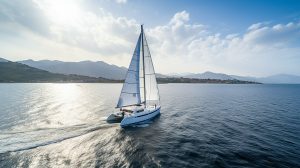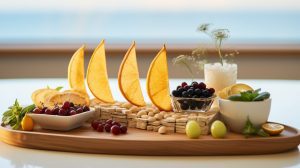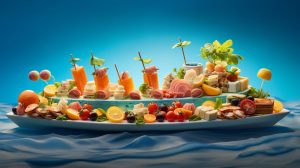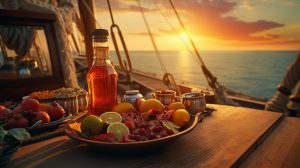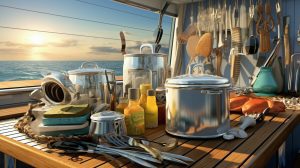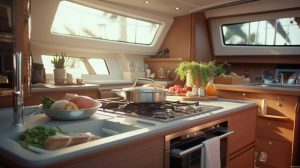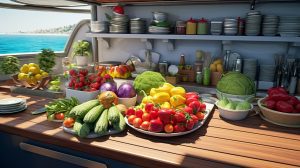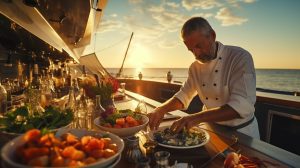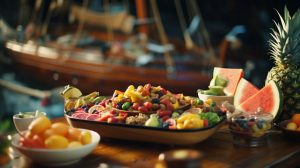Key points:
- Pasta, vegetables, fruit, bread, and meat are essential foods to bring on a sailing trip as they are versatile and can be used in a variety of meals.
- Pasta Carbonara, Tagliatelle with Olives, and Meat Risotto are simple and delicious meal ideas for sailing trips that can be made with the essential foods listed above.
- Kitchen appliances available on sailboats vary, but commonly include a refrigerator, stove with oven, and additional appliances on larger boats.
Table of Contents
- Key points:
- Essential Foods to Bring on a Sailing Trip
- Simple Meal Ideas for Sailing Trips
- Kitchen Appliances Available on Sailboats
- Conclusion
- Five Facts About Favorite Meals to Prepare and Eat While Sailing:
- FAQs about What Are Your Favorite Meals To Prepare And Eat While Sailing
- What should I eat while sailing?
- What to cook when sailing?
- How do you eat healthy while sailing?
- What is bow-tie-shaped pasta and can I prepare it while sailing?
- What is Parmigiano-Reggiano cheese and can I use it in my meals while sailing?
- Can I make simple meals while sailing if I don't have a lot of kitchen appliances?
- Read other posts in the Lifestyle Section
Essential Foods to Bring on a Sailing Trip
As an experienced sailor, I always make sure to pack essential foods for my trips. Bringing the right kind of food not only ensures that our tastebuds are satisfied, but also helps us stay energized and healthy while at sea. In this segment, we take a closer look at some of the essential foods that every sailor must bring along.
From carbohydrates-rich pasta to protein-packed meats, nutrient-dense fruits and vegetables, we cover all the essentials. We also delve into the importance of bringing food on a sailing trip. Let's dive in!
Pasta
- First, pasta is easy to store and prepare, making it perfect for a limited space environment like a sailboat.
- Second, pasta can be made into various dishes by adding vegetables, meat or seafood sauce, cheese or olive oil dressing.
- Third, pasta is nutrient-rich with carbohydrates which provide energy needed while sailing through the waters.
In addition to the above points, pasta is also an affordable option when considering food items for long trips on sailboats. Considering its versatility and nutrition value, many sailors prefer to cook delicious meals with pasta while sailing the high seas.
A notable event in history where pasta played an essential role was during World War II when Italian shipyard workers had access to surplus macaroni from exporting industries. The workers incorporated this into their home-cooked meals while they worked on building ships for the naval army. This staple meal eventually gained popularity across different parts of Italy soon after WWII ended.
For those looking to get their daily dose of greens, bringing vegetables on a sailing trip is a must - unless you want to end up feeling like a salty sea dog instead of a seaworthy sailor.
Vegetables
When planning to bring vegetables on a sailing trip, consider the following:
- Opt for sturdy vegetables that can withstand the journey without getting easily bruised or spoiled, like carrots, potatoes, cabbage, and onions.
- Canned or frozen vegetables could be a practical option to save space on the boat and increase shelf life.
- Don't forget about leafy greens like lettuce or spinach that can be used in salads or as toppings for sandwiches.
- Consider bringing herbs like basil, parsley, and thyme as they add freshness to any dish.
- Remember that some vegetables need to be kept separate from fruits due to their ethylene gas production that may cause other produce to spoil faster.
Additional details worth noting about vegetables include washing them before packing them on board and disposing of leftover scraps responsibly. Lastly, always plan meals ahead of time incorporating vegetable dishes into breakfast lunch and dinner menus.
During one sailing trip in the Mediterranean with friends, we collected fresh tomatoes from a nearby island on our second day at sea. We enjoyed tomato salads all week using fresh vegetables each day. It was a great reminder that fresh vegetables should never be overlooked when planning meals on sailing trips. Just remember, a pear a day keeps the scurvy away.
Fruit
For the sustenance and nourishment of sailors, 'fruits' are an essential addition to the food supply. They are not only a source of refreshment but also deliver concentrated nutrients, vitamins and minerals needed by the body.
The following table provides details about various fruits that could be taken along on sailing trips:
| Fruit | Nutrient Content | Benefits |
|---|---|---|
| Apples | Fiber, Vitamin C, Antioxidants | Boosts Immunity |
| Bananas | Fiber, Potassium, Vitamin C | Maintains Cardiovascular Health |
| Oranges | Vitamin C | Boosts Collagen Production |
| Pineapple | Bromelain Enzymes | Aids Digestion |
| Melons | High Water Content | Hydrates the Body |
In addition to being nutrient-dense, fruits offer culinary diversity and can be incorporated as sweet and savory snacks or components in entrees and desserts. Furthermore, dried fruits like raisins add flavor to dishes while providing added benefits like anti-inflammatory properties.
In history, sailors would often suffer from malnutrition-related illnesses due to inadequate diets focused on processed foodstuffs. Fruits were considered a crucial element during this time period since they provided necessary health benefits.
Don't forget the bread - it's the yeast you can do.
Bread
For sustenance on a sailing trip, bringing food is crucial. Bread, being a staple food in many parts of the world, can be a versatile and convenient option. Sadly I love bread and therefore I eat far more than I should!
A table can illustrate various bread options ideal for sailing trips. Bagels, buns, ciabatta, pita, sourdough, or whole grain sliced loaves are some examples that can be pre-purchased from the supermarket and last for a few days.
| Type of Bread | Description |
|---|---|
| Bagels | Dense rings perfect as breakfast or sandwich base |
| Buns | Soft rolls ideal to make on-board sandwiches |
| Ciabatta | Italian slipper-shaped loaf versatile in making meals |
| Pita | Puffed middle-eastern flatbread |
| Sourdough | Hearty, tangy bread that lasts 3-5 days without refrigeration |
| Whole Grain Loaf | Filled with fiber and protein for satiating nutrition |
Planning ahead by pre-slicing bread will save time and also space in the galley. Options like pitas or buns with pockets can be easily filled with fresh veggies or pre-cooked meats creating endless possibilities of easy-to-eat sandwiches.
Pro-tip: Wrapping bread in plastic wrap or aluminum foil before storing it in the onboard refrigerator leads to an extended shelf life while maintaining freshness.
Bringing meat on a sailing trip adds a whole new meaning to the phrase 'catch of the day'.
Meat
One essential food item to bring on a sailing trip is a variety of meat. Meats such as poultry, beef, pork, and fish are great sources of protein and can be cooked in a multitude of ways. Using meat in dishes like pasta carbonara or meat risotto can provide a filling and satisfying meal for sailors. It is important to portion and store meat properly to ensure freshness throughout the trip.
When preparing meals with meat on a sailing trip, it is crucial to consider the storage space available. Vacuum-sealed bags or pre-cooked options can help save space while still providing nutritious options for meals. Another option to keep in mind is using canned or cured meats like tuna or salami that have a longer shelf life.
In addition to traditional meats, seafood such as shellfish and prawns can make for excellent meals while sailing. Preparing prawns with green noodles or creating a shellfish pasta salad can add variety to the menu.
Pro Tip: When cooking meat on a sailboat, ensuring proper sanitation practices are followed is essential. Keep surfaces clean and disinfected during preparation and cook at appropriate temperatures to prevent any issues with contamination from bacteria or parasites.
Sailing without cheese is like sailing without wind - it just doesn't feel right.
Cheese
Incorporating dairy products, such as cheese, is essential while sailing. Cheese is a versatile ingredient that can be used to enhance flavor and add protein to a wide variety of dishes.
| Types of Cheese | Characteristics |
|---|---|
| Cheddar | Hard texture and savory taste |
| Feta | Crumbly texture with tangy flavor |
| Mozzarella | Soft texture and mild taste |
| Parmesan | Hard texture with nutty and salty taste |
Consider adding different types of cheese to pasta or sandwiches while sailing for a quick and satisfying meal. Additionally, cheese can be stored easily in the refrigerator on most sailboats.
A pro tip for bringing cheese while sailing is to vacuum seal it before storing it in the refrigerator. This ensures that the cheese stays fresh for longer periods and does not spoil quickly.
Sailing tip: Don't cry over spilled milk, bring a carton or two (or three) on board.
Milk
One crucial item to bring along on a sailing trip is dairy sustenance, for example, milk. It is fundamental not exclusively to benefit as much as possible from the handful of dinners accessible on board yet additionally for enhancing one's health and nourishment intake. Milk can likewise be utilized in various recipes.
In addition to milk, there are other essential food items that should not be overlooked. For instance, pasta serves as a versatile and cost-efficient meal option that can be cooked with ingredients like vegetables for additional nutrients while also being able to keep well aboard boats. Meat and cheese can also be great sources of protein and calcium respectively.
It should be mentioned that aside from using milk in coffee or tea, it can also feature in meals such as pasta carbonara or egg-based dishes like frittatas while also being an enriching source of vitamins like calcium.
Overall, preparation is key when packing for a trip at sea where resources could be limited. The importance of bringing essential food products such as milk cannot be overstated especially given its numerous benefits towards personal health and its versatility in meals preparations on sea trips.
Rice is a lifesaver on a sailing trip when you need a quick and filling meal to keep you going against the wind and waves.
Rice
- Rice is an excellent source of carbohydrates, making it a great energy source for sailors.
- Rice can be stored easily without taking up too much space in the galley.
- There are many different types of rice available, including long grain, short grain, brown, and wild, which can all be used in various recipes aboard a sailboat.
- Cooking rice is simple and requires only boiling water and a pot or pan to cook it in.
It is important to note that when bringing rice on a sailing trip, it's best to choose types that have longer shelf lives, such as white or brown rice. In addition, using rice in dishes like stir-fries or paella can provide filling and tasty meals for sailors.
When cooking rice on board, it's essential to keep the boat's motion in mind as it can affect cooking times and temperatures. It may also be helpful to invest in a rice cooker or pressure cooker if there is adequate storage space aboard the vessel.
In one instance, a group of sailors brought along several bags of different types of rice on their voyage across the Atlantic. They used the versatile ingredient in dishes like chicken curry and risotto throughout the journey while enjoying its warmth and comfort during cold nights at sea.
Nothing says 'good morning' on a sailing trip like a breakfast of fresh eggs and sea air.
Eggs
- They can be cooked in various ways, such as boiled, fried or scrambled.
- Eggs are a good source of protein, which is beneficial for keeping energized during long sails.
- They are also rich in vitamins and minerals, including vitamin D, vitamin B12, iron and selenium.
- When combined with pasta or rice, eggs make a quick and easy meal that can be prepared on board.
- Hard-boiled eggs can also be used as a snack or added to salads for additional protein.
Another benefit of bringing eggs on a sailing trip is that they have a relatively long shelf-life when stored properly.
According to the USDA National Nutrient Database, one large hard-boiled egg provides 6 grams of protein and is only about 77 calories.
Source: USDA National Nutrient Database
Bringing enough food on a sailing trip is like having a life jacket for your stomach.
Importance of Bringing Food on a Sailing Trip
While embarking on a sailing trip, it is crucial to take into account the importance of bringing food along. To keep yourself fueled and energized throughout the day while sailing, it is essential to have a nutritious and balanced diet that includes all the required food groups.
The absence of easily accessible grocery stores in certain areas and the limited storage space on sailboats emphasizes the importance of bringing food on a sailing trip. Bringing your own food ensures you have access to a variety of healthy meal options instead of having to rely solely on packaged or processed foods.
In addition to ensuring you have access to quality meals, there is also an economic advantage in bringing your own food as restaurants in marinas can be quite expensive. Additionally, some islands may not even have any dining places available.
To make sure that the necessary nutritional requirements are met, one could bring nonperishable items as well as fruits, vegetables, meat, pasta, rice etc. This provides boats with an ample supply of staple ingredients that can be used for making different meals without relying much on external factors.
Who needs a gourmet kitchen when you've got simple and delicious meal ideas like tuna salad with lentils and farfalle with anchovies?
Simple Meal Ideas for Sailing Trips
When I’m out on the water, I find that simple, delicious meals are the best way to keep up my energy and spirits. So, I’ve put together some meal ideas that are easy to make and satisfying to eat during long sailing trips. These meals range from pasta dishes like Pasta Carbonara and Farfalle with Anchovies to salads like Tuna Salad with Lentils and Carrot Salad with Marinated Anchovies.
I’ve also included some seafood options such as Prawns with Green Noodles and Shellfish Pasta Salad for those who love a taste of the ocean. And don’t forget to try out some classic Italian dishes like Tagliatelle with Olives and Fusilli with Tuna and Tomato Sauce!
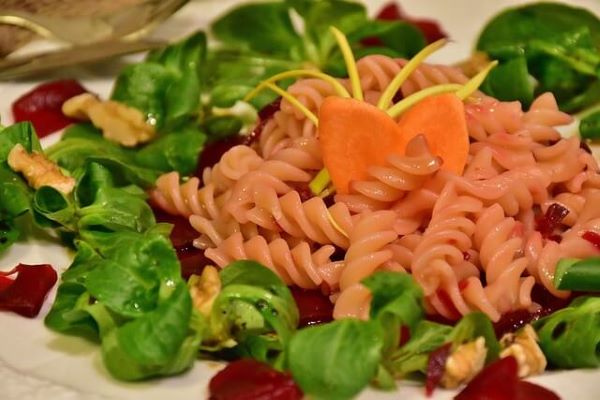
Tuna Salad with Lentils
A flavorful and nutritious meal option for sailors is the Tuna Salad with Lentils. This dish consists of cooked lentils, mixed greens, and flaked tuna, dressed with olive oil and vinegar.
Here are six key features of this dish:
- High in protein from the lentils and tuna
- A good source of fiber
- Fills you up without weighing you down
- Packs well for a day on the boat
- Quick and easy to prepare
- Tastes delicious!
Unique details worth mentioning include customization options such as adding chopped vegetables or topping the salad with a hard-boiled egg. Additionally, this versatile dish can be served warm or cold, making it perfect for any sailing occasion.
There are no specific historical anecdotes about Tuna Salad with Lentils, but it has become a popular choice among sailors due to its nutritional value and convenience on a sailing trip.
Get your daily dose of Omega-3 with this delicious Carrot Salad with Marinated Anchovies recipe.
Carrot Salad with Marinated Anchovies
Ingredients for Carrot Salad with Marinated Anchovies:
- Carrots: the salad's main ingredient, adds texture and crunch to the salad.
- Marinated anchovies: give the dish a salty flavor and pair well with the sweetness of the carrots.
- Lemon juice: adds tanginess and freshness to the salad.
- Olive oil: enhances the flavor of all ingredients and contributes healthy fats to your diet.
For additional nutrition, you can add other vegetables like cucumbers, tomatoes, or peppers to this salad. It can be served as a side dish or as a light lunch.
When making this dish on a sailboat, it is important to have all necessary ingredients on hand. Consider bringing lemons, olive oil, canned anchovies, and fresh carrots from home.
In one sailing adventure, we decided to make Carrot Salad with Marinated Anchovies using freshly caught fish instead of canned anchovies. It added an extra layer of flavor that made the recipe even more enjoyable.
Sail away with the delicious Farfalle with Anchovies recipe, guaranteed to make any landlubber jealous.
Farfalle with Anchovies
Here's a simple guide to prepare Farfalle with Anchovies:
- Cook farfalle pasta in salted boiling water, according to package instructions. Drain the cooked pasta and reserve about 1/2 cup of the cooking water.
- In a skillet, heat olive oil over medium heat. Add garlic, red pepper flakes, and anchovies. Cook for about 2 minutes or until the anchovies dissolve into the oil.
- Add the reserved cooking water to the pan and stir in the cooked pasta. Cook until the sauce has thickened slightly and clings to the pasta, for about 2-3 minutes more.
To add some extra flavor, top each serving of Farfalle with Anchovies with freshly grated Parmesan cheese.
Pro Tip: Cooking pasta al dente will not only retain its shape but also make it more flavorful when mixed with other ingredients.
Sailors beware, these prawns with green noodles will have you navigating the seas with a full and satisfied stomach.
Prawns with Green Noodles
This seafood and pasta dish is an excellent option for sailing trips. The prawns give a refreshing taste and green noodles add color to the meal.
- Cook the noodles as per the instructions on the package.
- Saute some garlic in oil over low heat until fragrant.
- Add some sliced bell peppers and sliced mushrooms. Saute for about three minutes.
- Add some peeled and deveined prawns to the pan. Cook thoroughly while stirring occasionally.
- Toss the cooked noodles into the pan, and mix it with the rest of the ingredients in it.
- Serve hot with a lemon wedge on top (optional).
As an alternative, you could use zucchini or spinach noodles instead of green colored ones. They work well, too!
Make sure you prepare this meal when there's minimal wind to ensure that everything remains steady on your boat.
Don't miss out on this delightful dish that compliments your sailing adventure! Nothing says luxury sailing like indulging in a delicious shellfish pasta salad amidst the endless blue horizons.
Shellfish Pasta Salad
This dish is a seafood lover's dream come true. A scrumptious Shellfish Pasta Salad includes varied types of shellfish cooked to perfection and mixed with al dente pasta. This seafood-infused salad is a crowd-pleaser and great for outdoor activities like sailing trips.
- It has a perfect blend of fresh mussels, clams and prawns.
- The dressing includes garlic butter, white wine, dill, salt, and black pepper.
- The addition of vegetables like cherry tomatoes, bell peppers and onions add color and crunch to the salad.
Additionally, this salad can be prepared in advance for a stress-free morning on the boat or eaten cold with minimal prep time.
Missing out on such an indulgent feast would be disappointing for any seafood enthusiast. Try your hand at this delicious Shellfish Pasta Salad recipe while sailing to get your fill of omega-3s!
Sail away with a taste of Italy and indulge in the creamy goodness of Pasta Carbonara while on your sailing adventure.
Pasta Carbonara
Here's a 6-step guide for making the perfect Pasta Carbonara:
- Boil water in a pot and cook spaghetti until al dente.
- Cook diced pancetta in a pan until crispy brown. Drain any excess fat from the pan.
- In a mixing bowl, whisk together eggs, grated parmesan cheese, and black pepper until they form a smooth mixture.
- Add the cooked spaghetti to the pan over low heat, then pour in the egg mixture while stirring constantly.
- Mix everything thoroughly for about one minute while ensuring that it cooks through without curdling. Remove from heat once fully cooked but still creamy.
- Serve hot with an additional sprinkle of parmesan cheese and cracked black pepper.
Pasta Carbonara is known to have many variations that you can decide on based on your taste preferences. Some people add heavy cream to make it creamier, while others use garlic instead of onion. You can choose to add mushroom or chicken as well if you like.
If you are sailing with family or friends don't miss out on preparing Pasta Carbonara seafood variation where you can add shelled shrimps, sliced calamari rings or mussels in place of pancetta for a twist of seafood and avoid missing out on creating unforgettable memories together whilst enjoying delicious food onboard.
Sail away with a hearty and classic pasta favorite - Pasta Bolognese.
Pasta Bolognese
This dish, a variant of the classic Italian cuisine, features pasta served with a particular meat-based sauce. The word 'bolognese' refers to the cooking style from Bologna, Italy. This sauce comprises browned ground beef cooked with vegetables and tomato paste seasoned with herbs and spices.
To make the Pasta Bolognese, first cook the ground beef in a pan while seasoning it with salt and black pepper. Next, add chopped onions and garlic followed by celery and carrots after some time has passed. Pour in tomato paste and canned tomatoes; add herbs like basil or oregano for flavoring; let everything simmer on low heat for a few hours until the meat becomes tender.
Some variations include using pork or veal instead of beef or even adding red wine to enhance its taste. This dish is hearty and filling, making it ideal for sailing trips where proper nutrition is necessary.
Sail away with the perfect combination of salty olives and savory tagliatelle.
Tagliatelle with Olives
For the dish of 'Tagliatelle with Olives', this classic Italian pasta dish is made with al dente tagliatelle noodles, tossed with a savory mix of black and green olives. The recipe contains healthy fats and protein along with complex carbs and fiber.
A Table for this dish can include Columns such as:
- Ingredients (tagliatelle pasta, olive oil, garlic, black olives, green olives, capers)
- Preparation Time (10 minutes)
- Cooking Time (20 minutes)
- Serving Size (4-6 people)
- Calories per Serving (roughly 300-400 calories)
To enhance the flavors of this dish, some unique details to keep in mind are that different types of olives will provide varied tastes and textures. Also, adding herbs like basil or oregano can add depth to the flavor profile.
To elevate this meal further, some suggestions could be to incorporate additional ingredients like sundried tomatoes or artichokes for extra complexity in taste. Additionally, using whole-grain pasta instead of regular pasta would add nutrients and fiber to the meal. Finally, serving with a side salad could enhance its nutritional value while still being delicious and satisfying.
Sail away with flavorful Fusilli and Tuna, a perfect match for your seafaring appetite.
Fusilli with Tuna and Tomato Sauce
- Step 1: Boil water in a pot and add fusilli pasta.
- Step 2: Cook the pasta for about 10 minutes or until it becomes al dente.
- Step 3: While the pasta is cooking, heat olive oil in a pan and sauté chopped onions and garlic until translucent.
- Step 4: Add canned tuna to the pan and stir for about a minute before adding tomato sauce, salt, pepper, and chili flakes to taste.
- Step 5: Mix well and simmer for another five minutes while stirring occasionally.
As this dish requires minimal preparation time, it is perfect for those days when you want to relax on deck or require nourishing food quickly.
A pro tip is using fresh herbs like parsley or basil to enhance the flavor of Fusilli with Tuna and Tomato Sauce.
Nothing beats a hearty meat risotto on a windy day at sea.
Meat Risotto
To prepare a hearty meal on a sailing trip, meat risotto is an excellent option. It is not only delicious but also easy to make and provides essential nutrition.
- Heat olive oil in a large Dutch oven over medium heat.
- Add diced onion and sauté until softened.
- Add garlic and Carnaroli rice, sauté for about two minutes.
- Pour a cup of dry white wine and mix well while simmering, add chicken or beef broth as needed while continuously stirring. Repeat the process until the broth has been fully absorbed by the rice.
- Once cooked, add diced beef or sausage and grated parmesan cheese, continue to stir and cook until all ingredients are combined well.
- Garnish with fresh parsley or basil leaves before serving.
It is also worth noting that risotto can be made with various different meats such as chicken, seafood, or vegetables for those who don't eat meat. A group of sailors was once stuck on their sailboat when bad weather conditions prevented them from reaching their planned destination. The only thing they were able to do was cook meals together. Luckily, one sailor knew how to make meat risotto which became everyone's favorite dish during this time. By taking advantage of what they had brought along with them, they were able to create lasting memories while still enjoying delicious meals amidst challenging circumstances. Sailing and tapenade go together like waves and wind - a match made in culinary heaven.
Tapenade
A Unique and Traditional Spread
Tapenade, a traditional Mediterranean spread, is often found on the menu of sailing trips due to its easy preparation and versatility. Here are some points to know about tapenade:
- Tapenade is made by blending together black olives, capers, anchovies, garlic, and various herbs like thyme or basil.
- The spread can be slathered onto bread or crackers for an appetizer, or used as a condiment for sandwiches and wraps.
- Pairing tapenade with other items like roasted red peppers or goat cheese can enhance the flavor profile.
- It's often found as a topping on popular Mediterranean dishes such as pasta or pizza.
For a more unique spin on traditional tapenade, consider adding in sun-dried tomatoes or different types of nuts.
One interesting fact about tapenade is that it originated in Provence, France and was traditionally made solely from capers.
Bruschetta: the perfect way to use up stale bread and pretend you're still eating fresh ingredients on a sailing trip.
Bruschetta
- Bruschetta is typically made with crusty bread such as baguette, ciabatta, or sourdough.
- The bread is usually toasted or grilled before being rubbed with garlic and drizzled with olive oil.
- Tomatoes are a common topping for bruschetta, but it can also be topped with fresh herbs, cheese, cured meats, or vegetables.
- While bruschetta is often served as an appetizer or snack, it can also be used as a base for other dishes like salads or pasta dishes.
- The origins of bruschetta are debated among food historians but are thought to date back to ancient Rome when the olive harvest was celebrated by grilling bread and rubbing it with garlic and olive oil.
Bruschetta is a versatile dish that can be easily customized to suit different tastes and preferences. It's perfect for serving at parties or gatherings since it can be prepared in advance and doesn't require any utensils to eat.
Why settle for camping when you can have a fully equipped kitchen on a sailboat?
Kitchen Appliances Available on Sailboats
As someone who enjoys sailing, preparing meals on board can be a unique challenge. That’s why it’s important to have access to the right kitchen appliances while on the water. Let's talk about the equipment options available on sailboats. First, there's standard kitchen equipment that you can expect on most charter boats. Next, every boat comes with a refrigerator and stove with an oven, which provides ample opportunity to prepare delicious meals. Finally, larger sailboats offer additional kitchen appliances that can make cooking even more enjoyable. So, let's dive in and explore these options in greater detail.
Standard Kitchen Equipment on Charter Boats
Boats' standard kitchen appliances may vary depending on the boat's size and purpose. Below are some of the common kitchen equipment available on charter boats.
- Stove with Oven: Every boat comes equipped with a stove that burns propane gas or alcohol, which can be used to prepare a range of meals.
- Refrigerator: A standard-sized fridge is installed in every boat, which allows crew members to store all kinds of perishable goods, including meat, veggies, and fruits.
- Cutlery and Crockery: Utensils and Plates for eating are provided on the boat. However, Chef knives and other high-end cookware must be brought by passengers themselves.
- Sink: Every boat has a sink to use for cleaning utensils and washing produce.
- Kitchenette Area: The kitchen typically contains counter space along with cabinet space beneath it to store food.
Distinct types of boats will have slightly different amenities accessible so make sure to check them before sailing. It is always better to bring things necessary for cooking gourmet cuisine if you're unsure what will be present.
Once while sailing on my brother's charter boat rental service in the Mediterranean area on board a 44ft catamaran boat, I managed to prepare an extravagant grilled fish feast featuring fresh tuna caught by us during our trip. We had stored the fish in refrigeration units provided by the charter company on board, and using the oven made scrumptious stuffed bell peppers as an excellent accompaniment to our seafood meal.
Even on the high seas, you can still whip up a culinary masterpiece with the standard kitchen equipment on charter boats.
Refrigerator and Stove with Oven on Every Boat
Boats equipped with the standard kitchen facilities include refrigerator and stove with oven on every boat. These appliances are must-have for any sailing trip. Additionally, larger boats have additional kitchen appliances available for use.
Furthermore, refrigerators keep food fresh; hence, they are an essential asset to have during sailing trips. Stoves come in handy when preparing different cuisines while the oven is ideal for baking cakes and bread.
Moreover, it is recommended to buy a cooler that is small enough to fit in your cabin but can also hold a substantial amount of drinks and food.
Some crucial suggestions would be stocking up on canned and non-perishable items such as pasta, rice, beans and canned vegetables. Food prepping before the trip helps save time, so prepare some meals ahead of time for smoother sailing days. Try packing some ice packs in coolers instead of buying bags of ice as they will melt quickly in hot climates.
Take your sailing experience to the next level with these additional kitchen appliances on larger boats, because who needs a dull and hungry trip?
Additional Kitchen Appliances on Larger Boats
Larger sailing vessels tend to have more extensive kitchens than their smaller counterparts, and thus they are likely to be better equipped with additional kitchen appliances on larger boats. These can include coffee makers, blenders, food processors, and microwaves. While these appliances may not be essential for basic cooking needs, they can help make meal preparation easier and more enjoyable for those on board.
Sailboats that are designed for longer voyages may also have space-saving appliances such as combination washer-dryers and dishwashers. These additional kitchen appliances on larger boats can help reduce clutter and ensure that crew members can stay clean and well-fed throughout the trip.
While some sailors may prefer the simplicity of cooking over an open flame or using minimal kitchen equipment, additional kitchen appliances on larger boats can certainly add both convenience and comfort to a sailing adventure.
Conclusion
Sailing and cooking have a long-standing bond. Food is an essential aspect of sailing as it provides sustenance and energy to thrive in the water. Favorite meals to prepare and eat while sailing vary depending on personal taste and cooking skills. Meal prepping and cooking equipment are equally essential to ensure a pleasurable sailing experience. Sailing enthusiasts should find recipes that are easy to prepare, non-perishable, and offer a balanced diet.
In addition to easy-to-prepare recipes, sailing enthusiasts should consider the type of vessel they are on when meal prepping. For example, a sailboat with a small kitchen may limit the type of meals to prepare and consume. Therefore, choosing meals that do not require complicated cooking equipment is crucial. Additionally, weather conditions might affect the cooking process, and thus, sailing enthusiasts should select meals that can be prepared with minimal preparation time and effort.
Furthermore, while preparing meals to eat while sailing, it is important to pack non-perishable food items as they will last longer. Items such as canned goods or dried fruits provide a longer shelf life and are perfect for long sailing trips. Planning a meal calendar and preparing in advance will reduce stress and ensure that there is a variety of meals to eat while sailing.
Sailing enthusiasts are encouraged to explore new recipes and flavors to enhance their sailing experience. With the right meal prepping and cooking equipment, sailing and cooking will create beautiful memories that will last a lifetime. Don't miss out on the chance to elevate your sailing adventure with delicious and easy-to-prepare meals.
Five Facts About Favorite Meals to Prepare and Eat While Sailing:
- ✅ On a sailing trip, it is recommended to bring pasta, vegetables, fruit, bread, meat, cheese, milk, rice and eggs as the essentials to make almost anything.
- ✅ Simple but delicious meals that can be prepared while sailing include tuna salad with lentils, carrot salad with marinated anchovies, farfalle with anchovies, prawns with green noodles, and pasta carbonara.
- ✅ Charter boats come with standard kitchen equipment including dishes, cutlery, mugs, glasses, bowls, and pans. Larger boats may also have a microwave, ice-maker, and other appliances available.
- ✅ The most important factor in preparing meals while sailing is that they are not time-consuming so that you can enjoy your holiday to the fullest.
- ✅ If you are skilled or lucky, you may be able to catch your own fish or shellfish while sailing.
FAQs about What Are Your Favorite Meals To Prepare And Eat While Sailing
What should I eat while sailing?
On a sailing trip, you should bring pasta, vegetables, fruit, bread, meat, cheese, milk, rice, and eggs. These are the ingredients you can make almost anything with. You should always bring some food on a sailing trip. It is the best option as you will not always need to go back to the land to fill your stomach.
What to cook when sailing?
Our suggestions include tuna salad with lentils, carrot salad with marinated anchovies, farfalle with anchovies, prawns with green noodles, shellfish pasta salad, pasta carbonara, pasta bolognese, tagliatelle with olives, fusilli with tuna and tomato sauce, meat risotto, tapenade, and bruschetta. The most important factor is that it is not time-consuming because you want to enjoy your holiday to the fullest.
How do you eat healthy while sailing?
Bring along fresh fruits, vegetables, lean proteins, and whole grain options. Opt for grilled rather than fried or processed foods. Stay hydrated by drinking plenty of water and avoiding sugary drinks. Plan ahead and store the food in the fridge and just cook it as the days go by to ensure a healthy and balanced meal.
What is bow-tie-shaped pasta and can I prepare it while sailing?
Farfalle pasta is bow-tie-shaped pasta made from durum wheat flour, which creates a firm, chewy texture that holds up well while cooking. Yes, you can prepare farfalle pasta while sailing. One delicious recipe is farfalle with anchovies.
What is Parmigiano-Reggiano cheese and can I use it in my meals while sailing?
Parmigiano-Reggiano cheese is a hard, granular cheese made from cow’s milk and aged for two years. It originated in the Parma and Reggio Emilia regions of Italy. Yes, you can use Parmigiano-Reggiano cheese in your meals while sailing. It is a delicious addition to pasta dishes and salads.
Can I make simple meals while sailing if I don't have a lot of kitchen appliances?
Yes, charter boats come with standard kitchen equipment – dishes, cutlery, mugs, glasses, bowls, and pans. When it comes to kitchen appliances, you will find a refrigerator and stove with an oven on every boat. You can still make delicious and simple meals with these basic kitchen appliances.
Read other posts in the Lifestyle Section
- What is Blue Water Sailing? All you need to know.Blue water sailing is an exciting and challenging form of sailing that involves voyages across open waters, typically beyond the sight of land. It is a thrilling way to explore the vastness of the ocean, test your skills, and push your limits. Whether you are a seasoned sailor or someone who has never sailed before,… Read more: What is Blue Water Sailing? All you need to know.
- Is Blue Water Sailing Dangerous? Uncover the Truth Today!Embarking on a blue water sailing journey can be a thrilling experience, but it also comes with inherent risks. Long-distance sailing can be challenging and unpredictable, making it crucial to understand the potential hazards and prepare accordingly. In this section, we will explore the question of whether blue water sailing is dangerous. We will discuss… Read more: Is Blue Water Sailing Dangerous? Uncover the Truth Today!
- Exploring What Size Catamaran for Blue Water Sailing Is IdealPlanning a blue water sailing adventure requires careful consideration of various factors, including the size of the catamaran. The size of the catamaran plays a critical role in ensuring a comfortable and safe journey on the open ocean. But what size catamaran for blue water sailing is ideal? In this section, we will explore the… Read more: Exploring What Size Catamaran for Blue Water Sailing Is Ideal
- Easy & Non Messy Boat Snacks for Your Next Sailing Adventure!Welcome aboard, fellow sailors! As you prepare for your next adventure on the water, one thing you don't want to forget is snacks. However, the last thing you want is to deal with messy, crumbly snacks that leave a trail behind and attract unwanted bugs. That's why it's important to opt for non messy boat… Read more: Easy & Non Messy Boat Snacks for Your Next Sailing Adventure!
- Easy & Delicious Finger Food Ideas for Boating AdventuresWelcome aboard! No boating adventure is complete without some delicious and easy-to-eat finger foods. Whether you're cruising down the river or sailing into the sunset, having the right snacks is essential for a successful day on the water. If you're looking for some inspiration for your next boating trip, look no further. We've rounded up… Read more: Easy & Delicious Finger Food Ideas for Boating Adventures
- Quick & Easy Meals to Cook on a Boat: Nautical Nutritious RecipesAre you planning a high seas adventure and looking for easy meals to cook on a boat? Look no further! In this section, we've compiled a selection of boat-friendly recipes that are hassle-free and packed with nutrients. These recipes are designed to be cooked with minimal resources and are perfect for those who want to… Read more: Quick & Easy Meals to Cook on a Boat: Nautical Nutritious Recipes
- Essential Kitchen Utensils for Cooking While Sailing - Nautical GuideAre you planning a sailing adventure and want to enjoy delicious meals on board? Cooking in a sailboat kitchen can be challenging, but with the right tools, you can prepare tasty meals while enjoying the sea breeze. In this nautical guide, we will discuss essential kitchen utensils for cooking while sailing, so you can be… Read more: Essential Kitchen Utensils for Cooking While Sailing - Nautical Guide
- Discover Top Meal Planning Tips for Sailing Trips Today!Embarking on a sailing trip is an exciting adventure, but it's crucial to be well-prepared, especially when it comes to mealtimes. To fully enjoy your sailing experience, it's important to have a well thought out meal plan that takes into consideration the limited space, resources, and time available on a sailboat. In this article, we'll… Read more: Discover Top Meal Planning Tips for Sailing Trips Today!
- Essential Guide to Must-Have Ingredients for Cooking on a BoatWelcome aboard, fellow travelers! If you're planning on cooking while on a boat or a yacht, you need to make sure you have the right ingredients. Cooking on a boat doesn't come without its challenges, and you need to be able to adapt to them. Whether you're a seasoned sailor or a first-time boater, this… Read more: Essential Guide to Must-Have Ingredients for Cooking on a Boat
- Must-Try Convenient Snacks for Sailing Excursions Guide!If you're planning a sailing excursion, you know how important it is to pack the right snacks. Whether you're heading out for a day trip or an extended journey, having convenient and delicious snacks on hand can make all the difference. In this guide, we'll explore a variety of snacks that are perfect for sailing… Read more: Must-Try Convenient Snacks for Sailing Excursions Guide!
- Discover Simple and Healthy Sailing Recipes for Your Next VoyageAre you planning your next sailing adventure and looking for easy and nutritious meal ideas to keep you energized on the water? Look no further than simple and healthy sailing recipes! These delicious recipes are not only easy to prepare but also packed with essential nutrients to keep you fueled all day long. In this… Read more: Discover Simple and Healthy Sailing Recipes for Your Next Voyage
- Discover the Best Food to Take on a Sailboat Trip: Your GuideEmbarking on a sailboat trip is an exciting adventure that requires careful planning, especially when it comes to food. The right food can make or break your trip, so it's crucial to consider what to pack and how to store it. In this guide, we'll cover all the essentials to ensure that you have the… Read more: Discover the Best Food to Take on a Sailboat Trip: Your Guide



